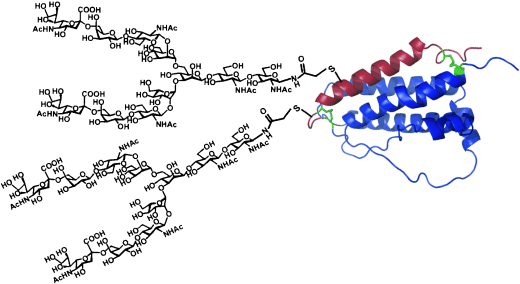|
Related Topics: |
|
|
|
Current News |
|
Chemistry A to Z |
|
About Internetchemistry |
Glycoprotein Analogues |
|
Erythropoetin, abbreviated EPO, has gained a scandalous reputation as a doping agent for racing cyclists. The name is derived from the ancient Greek erythros “red” and poiein “to make”, a fitting designation for this important growth factor, which is responsible for the formation of red blood cells in the body. Biotechnologically produced erythropoetin, aside from its implementation as a drug for cyclists, is primarily used to treat anemia in dialysis patients after aggressive chemotherapy. A Japanese and British team led by Yasuhiro Kajihara has now successfully produced analogues of this factor in a synthesis that is half biotechnological and half chemical. As the researchers report in the journal Angewandte Chemie, this synthetic route could be an attractive general approach for the production of glycoproteins—proteins that have side-chains of sugar building blocks. |
|
|
EPO is a well-investigated glycoprotein with a known, clearly delineated biological function. It is thus favored as a model glycoprotein. Its protein component is made of 166 amino acids, and four complex sugar chains (oligosaccharides) are bound to it like branched antennas. They increase the lifetime of the protein in the blood. Glycoproteins are important pharmacological agents; however, they are difficult to produce. In cell cultures, no uniform saccharide chains are formed. In addition, bacteria are not able to recreate the complex oligosaccharides found in mammals. The alternative approach, chemical synthesis, is capable of producing tailored, uniform glycoproteins that can fulfill the function of glycoproteins as drugs and for research. However, this approach is very expensive.
The team has found a happy medium: they used a biotechnology approach to produce only one part of the EPO protein chain in a bacterial culture. They used chemical synthesis to produce the second, shorter part of the protein chain with the sugar antennas. They introduced a synthetic anchoring site, to which sugars can be chemically attached. The saccharide used was a branched complex sialyloligosaccharide from egg yolks. In the final step, the researchers hooked together the two protein chains by a method known as native chemical ligation. Folding experiments demonstrated that, like natural EPO, the synthetic EPO analogue assumes a helical structure. Cell proliferation assays with bone marrow cells yielded a biological activity equal to that of the original. In vivo, the analogue could not increase the red-blood-cell count in the same way as true EPO. The researchers hope that by using different, more highly branched oligosaccharides they will be able to create analogues that also demonstrate high bioactivity in vivo. |
|
|
|

